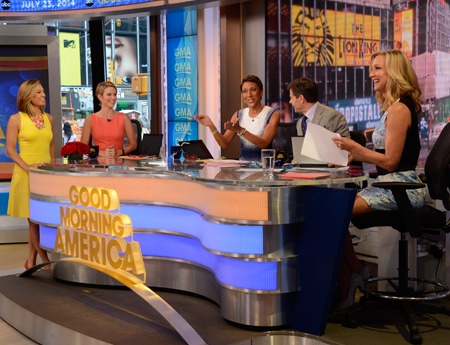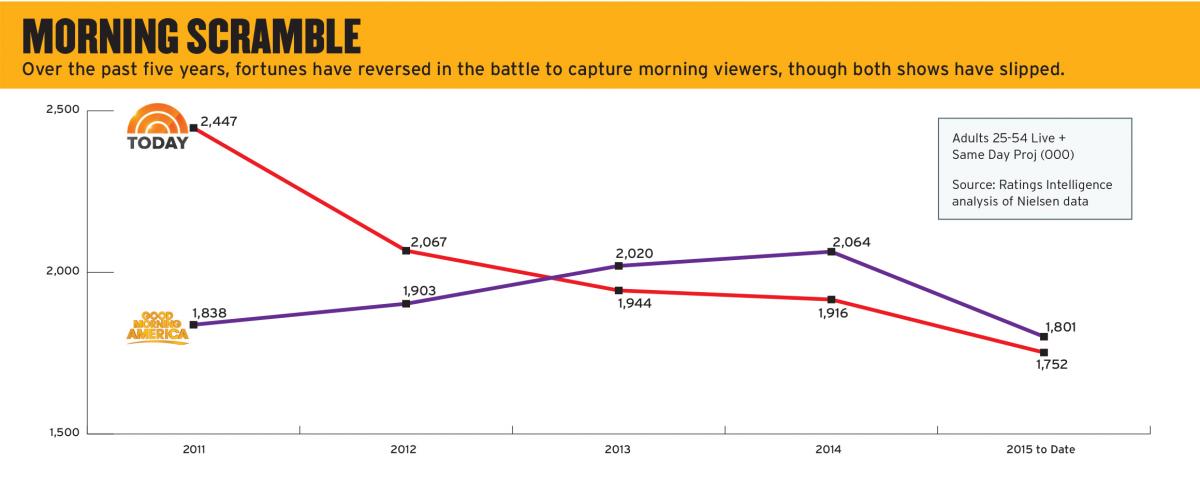The Billion-Dollar Breakfast Battle

Times Square is uncharacteristically quiet at 6:59 a.m. on a chilly fall Tuesday. A stream of cabs zips through the intersection outside the Good Morning America studio at 44th Street and Broadway, not yet steady enough to cause the honk of a horn. A dozen fans of the show press up against the windows as the GMA team prepares to go live. Terrie McCaleb of Hutto, Texas, holds a sign that reads “Home of the Hippos.” It’s Hutto High School’s mascot, she explains.
McCaleb attended a wedding in Pittsburgh , and she, her husband and son decided to venture further east to New York. Their son is a firefighter, so they aimed to hit the 9/11 Memorial and Museum. GMA is Terrie’s favorite show, which is how she ended up in Times Square on this October morning.
“I love how transparent Robin is about her life,” says McCaleb of Robin Roberts, cancer’s most public survivor. “I love the genuineness, the sincerity. I had to be here.”
Seven o’clock is precisely when a gray-blue sky shifts to blue-gray. It’s also when Roberts, George Stephanopoulos and the rest of the GMA team go live, same as their Today counterparts do, five blocks north and one block east, as another brutal a.m. television battle gets underway. The stakes are immense. Besides bragging rights, choice bookings and the chance to set up a viewer’s remote for the subsequent dayparts, there’s close to a billion dollars in play for the three broadcast morning shows.
“It’s an incredibly important show for us,” says James Goldston, ABC News president and himself a former GMA senior executive producer. “And it’s a show we’re very proud of.”
Forty Years of ‘GMA’
Good Morning America launched 40 years ago this week, a relaunch of a struggling program called A.M. America. The show was part of ABC’s entertainment division and featured a pair of actors as hosts, David Hartman and Nancy Dussault. It took GMA five years to pull level with Today, with an assist from the 1980 Lake Placid Olympics and a host change that brought Joan Lunden to the fore. GMA and Today, the NBC program with a 23-year head start, went back and forth for much of the next decade and a half, until The Streak.
The smarter way to stay on top of broadcasting and cable industry. Sign up below
Today, powered by the emergent hosting duo of Matt Lauer and Katie Couric and shrewd choices by producers from Jeff Zucker to Jim Bell, famously held the morning ratings title for 16 years, or 852 weeks. Then, as the talent shifted at NBC, its format, stubbornly, did not, and Good Morning America made its move. “We felt the entire morning show genre was ripe for reinvention,” says Goldston. “The format has been the same for the best part of a generation.”
Producers pushed newer technologies, such as using emerging iPhone functionality to send home reports from all corners of the globe. Instead of the traditional male-female anchor setup, GMA featured more free-form discussions, a gaggle of talent crowded around a table, taking advantage primarily of Roberts’ viewer appeal.
GMA crept ahead in the spring of 2012. The victory was so cataclysmic that, according to the book Top of the Morning: Inside the Cutthroat World of Morning TV, the celebration at ABC News headquarters in New York was beamed to network bureaus in other cities.
Executive producer Michael Corn credits the talent’s broad appeal for the win. “I truly think we have the best on-air team in the business,” he says. “It’s a team that is truly in touch with real people.”
These days, it’s a jump ball. Today poached the lead in viewers 25-54 from GMA in July after trailing each month of 2015, according to Ratings Intelligence. GMA reclaimed the lead in August, but Today moved back ahead in September and was leading in October.
Plus, keeping both heavyweights on their toes is CBS This Morning, giving viewers a more straight-laced approach to morning news, along with increasingly popular cable news programs such as Morning Joe.
Through Oct. 23, GMA’s average of 4.8 million total viewers paced ahead of Today’s 4.4 million. But GMA was 11% down in total viewers across the first four weeks of the fall season (Sept. 21-Oct. 16), versus the same time interval last year, per Ratings Intelligence, while Today was minus 3% in that span. CBS This Morning, on the other hand, was up 11%.
“GMA had huge momentum, but doesn’t look as though they have that now,” says AndrewTyndall, news analyst. “The Today show has managed to stem the leak, and GMA looks as though it has stalled.”
The battle to one-up the other is constant. GMA marks its 40 years on the air with a unique stunt, live-streaming the show for 40-straight hours Nov. 17-19, with past hosts such as Hartman, Dussault and Sam Champion turning up to salute GMA’s four decades in morning television.
There are nearly a billion reasons to bring your A-game each morning. According to a study from Pew Research Center, CBS This Morning hauled in $162 million last year, with GMA at $363 million, and Today at $435 million. (Today is a four-hour-long show, while GMA is two.)
Chemistry Lesson
To watch the GMA production progress from 7 to 9 a.m. is like watching a board game being played. The team—anchors Roberts and Stephanopoulos, news anchor Amy Robach, co-anchor Lara Spencer and chief meteorologist Ginger Zee, and appearances from other fresh-faced up-and-comers—starts at the main anchor desk and moves clockwise around the set, to a more informal table, to a living room set, out to the plaza for a spell, before having traveled 360 degrees back home to the main desk.
In the middle on this particular day are stories about Oprah Winfrey investing in Weight Watchers, musician Travis Barker talking about surviving a plane crash and his new book, a sex scandal at the University of Louisville, a man claiming a spider bite defense in explaining his car accident, and several reports from the previous night’s Dancing With the Stars, which Corn calls “a perfect fit” for the show’s second hour.
For years, GMA drew motivation from its underdog status. With the ratings race so close, it is thinking that way again. Asked what motivates her to climb out of bed each day to do battle, Roberts responds, “Knowing that I have the privilege of saying good morning to America. I cherish the opportunity to start someone’s day off on the right foot. We don’t take it for granted that people graciously invite us into their homes and into their lives every morning.”
Roberts says it’s a “blessing” to harbor genuine affection for your work colleagues. While one never knows how much of the talent bonhomie is genuine, the cheery vibe on the set does appear authentic. A degree of chaos is inherent in any live production, but order seems to prevail on this particular morning. Talent and set grunts mingle freely during breaks, with a shorthand and degree of comfort one might not expect across such disparate cliques. When stage manager Angie Morreale—like Roberts, a cancer survivor—addresses Robertsas “darlin,” the affection is obvious.
Robach has some perspective on workplace chemistry, having worked on the weekend Today prior to turning up at GMA. “I have to tell you, the atmosphere is night and day,” she says. “It’s fun. It’s familial. It sometimes feels like a circus, a party, the energy is so vibrant here. Walking in in the morning, you feel it.”

No one would reasonably expect the hosts to head out for mimosas after the show wraps, but Spencer says spending some time outside of work helps build the on-air rapport. “We are genuinely friends,” she says. “We are very interested in what each other has to say.”
Stephanopoulos, who is chief anchor within ABC News, may seem miscast when the chatty roundtable format takes over on the topic of, say, dating, but he plays along gamely. His legs crossed and one arm casually extended along the back of the sofa on this particular day, Stephanopoulos simply smiles when he doesn’t have an ad lib to toss in to the frothy mix. He says the show, despite its personality-driven nature, is built to withstand personnel changes, such as when Champion left for Weather Channel and Josh Elliott for NBC Sports.
“It’s a bunch of people who are curious about the world and are ready to come in and have fun every morning,” he tells B&C. “We give a lot of information, and we try to have a good time while doing it.”
The final half-hour has Stephanopoulos interviewing film/TV star Bradley Cooper, the pair facing off in director chairs. The dozen or so guests of the show on-set—contest winners, friends of friends—inch closer for a photo of the A-list star. A stunt involving a cadre of Philadelphia Eagles cheerleaders out on the plaza—Cooper is a huge Eagles fan—elicits a laugh from stage manager Eddie Luisi so hearty you could almost hear it at Bubba Gump Shrimp Co. across Times Square.
‘Today’ and Tomorrow
Just before 9 a.m., as the rest of the city is hustling to work, the a.m. television denizens put the show to bed. “Thank you, everyone,” yells out Luisi, as Spencer slips into a comfy pair of Uggs.
A round of applause breaks out, an uncommon act for a Tuesday. “Is it a Friday?” wonders one photographer aloud. “Did I miss something?”
Outside, two of the unsung laborers on the set spark up Marlboros in a doorway a few addresses down from the studio. They say the chemistry that propelled GMA to a historic win 3½ years ago is genuine. They note the lack of barriers between stars and crew that defines other shops. One mentions how Roberts fawns over his kids when he brings them to work.
“I’ve been in this business 25 years,” he says, reeling off a list of TV operations in a thick Noo Yawk accent. “This is a nice collective group. It’s just like family, know what I mean?”
But the family is in for a fight. GMA has come an awful long way since Hartman stepped onto the set four decades ago, but will have to keep evolving to take it to Today each day.
“Over the last 40 years, we’ve built one of the great brands in the media,” effuses Goldston. “I can’t wait to see what we do in the next 40 years.”
Michael Malone is content director at B+C and Multichannel News. He joined B+C in 2005 and has covered network programming, including entertainment, news and sports on broadcast, cable and streaming; and local broadcast television, including writing the "Local News Close-Up" market profiles. He also hosted the podcasts "Busted Pilot" and "Series Business." His journalism has also appeared in The New York Times, The L.A. Times, The Boston Globe and New York magazine.

